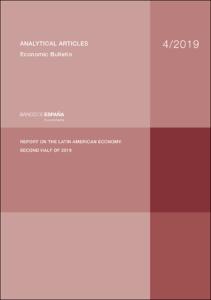Registro completo de metadatos
| Campo DC | Valor |
|---|---|
| dc.coverage.spatial | América Latina |
| dc.date.accessioned | 2020-03-24T07:43:47Z |
| dc.date.available | 2020-03-24T07:43:47Z |
| dc.date.issued | 2019-11-07 |
| dc.identifier.uri | https://repositorio.bde.es/handle/123456789/10793 |
| dc.description | Artículo de revista |
| dc.description.abstract | This article analyses the recent performance of the main Latin American economies (Brazil, Mexico, Argentina, Colombia, Chile and Peru). In the first three quarters of 2019 the region’s growth was once again lower than expected and below that of other emerging areas of reference. This lower growth is essentially explained by domestic factors (political and economic policy uncertainty and structural problems of low potential growth), although the external environment has not been favourable either in terms of developments in world demand and in the terms of trade. Most central banks in the region have reduced policy interest rates given the absence of inflationary pressures, the existence of negative output gaps and the relatively stable performance of exchange rates. Fiscal space is limited in most of the economies and certain risks to the sustainability of their public finances persist in some of them. The main international organisations and private institutions expect activity to rise in the coming quarters, especially domestic demand. This would be based on looser financial conditions and improved external conditions (lower trade tensions) and domestic conditions (agents’ confidence). In this setting, the balance of risks is tilted downwards, given the persisting doubts about economic policies in the main countries in the region and about the dissipation of political uncertainty, and about the improvement of the international economic situation. This report includes two boxes. Box 1 analyses the channels which could be transmitting global trade tensions to Latin America. Box 2 describes the economic situation in Argentina after the worsening of the financial turmoil last summer. |
| dc.format.extent | 22 p. |
| dc.language.iso | en |
| dc.publisher | Banco de España |
| dc.relation.ispartof | Economic Bulletin / Banco de España, 4/2019 |
| dc.relation.hasversion | Versión en español 123456789/10117 |
| dc.rights | Reconocimiento-NoComercial-CompartirIgual 4.0 Internacional (CC BY-NC-SA 4.0) |
| dc.rights | In Copyright - Non Commercial Use Permitted |
| dc.rights.uri | https://creativecommons.org/licenses/by-nc-sa/4.0/deed.es_ES |
| dc.rights.uri | http://rightsstatements.org/vocab/InC-NC/1.0/ |
| dc.subject | Low growth |
| dc.subject | Political and economic policy uncertainty |
| dc.subject | Trade tensions |
| dc.subject | Monetary policy |
| dc.subject | Fiscal space |
| dc.subject | International economy |
| dc.title | Report on the Latin American economy. Second half of 2019 |
| dc.type | Artículo |
| dc.contributor.corporated | Banco de España |
| dc.identifier.bdebib | 000469032 |
| dc.identifier.bdepub | ECBU-2019-4B-art33 |
| dc.subject.bde | Evolución y desarrollo económicos |
| dc.publisher.bde | Madrid : Banco de España, 2019 |
| dc.subject.jel | F01 |
| dc.subject.jel | F21 |
| dc.subject.jel | F30 |
| dc.subject.jel | F41 |












